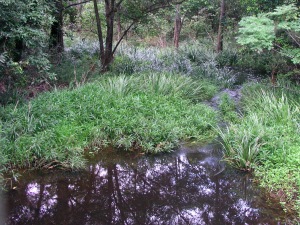The platypus has long elicited excitement and controversy in the zoological world. While our understanding of their biology and genetic make-up has improved, this icon of Australian freshwater still retains an air of mystery.
Despite over 10 years sampling creeks around Australia, I have to confess to only two platypus sightings. I recently joined a dedicated community group (Platypuswatch) to see if I could improve my stats.
As we prepared for our dawn expedition to one of Brisbane’s suburban creeks, I realised the unsociable hours of the creature partly explained not only my poor sighting rate, but a general lack of understanding about platypus behaviour*.
The platypus (Ornithorhynchus anatinus) has so many fun facts and figures its hard to know where to start. Initially, the most controversial aspect of platypus biology was whether or not they lay eggs like birds and reptiles*, despite having all that lovely fur. They do.
But, females also lactate (produce milk) which is a very mammalian thing to do. Newly hatched platypus (sometimes called puggles) suck milk directly from the abdominal skin, as females lack nipples.
This has put platypus with the echidna in the group of mammals known as monotremes. They have the unglamorous distinction of a single opening for “things going out” and reproduction.
A draft genome sequence for the platypus was published in 2008*. As well as finding a blend of mammalian and reptilian genes one of the interesting discoveries was their large arsenal of genes related to immunity. It is thought that this unusual feature may arm the undeveloped young platypus with a diverse range of innate immune responses.
The male platypus is also equipped with poison glands. Only a handful of mammals are venomous, but the male platypus is unique among them in delivering its poison not via a bite but from hind-leg spurs.
So the cute platypus is not completely defenceless. They have also proven to be reasonably hardy in the face of human impacts on waterways. This means the platypus is not currently listed as of conservation concern except in South Australia (where it is thought to no longer occur).
I spent a peaceful dawn sitting by a creek. Scanning all the ripples on the pool surface and listening to the dawn chorus of lorikeets and cockatoos. Unfortunately my group didn’t sight a platypus. I’m hoping it’s just the vagaries of wildlife spotting rather than an indication the platypus are losing their toehold in Brisbane. The efforts of volunteers can help find the answer.
*The full article on which this piece is based is: Genome analysis of the platypus reveals unique signatures of evolution. By: W.C. Warren et al. Nature, 2008, 453, 175-83. http://www.nature.com/nature/journal/v453/n7192/full/nature06936.html
To find out about Platypuswatch see: Australian platypus conservancy: http://www.platypus.asn.au/



Hoping you get to see some more with your adventures! I still haven’t ticked that wildlife box yet.